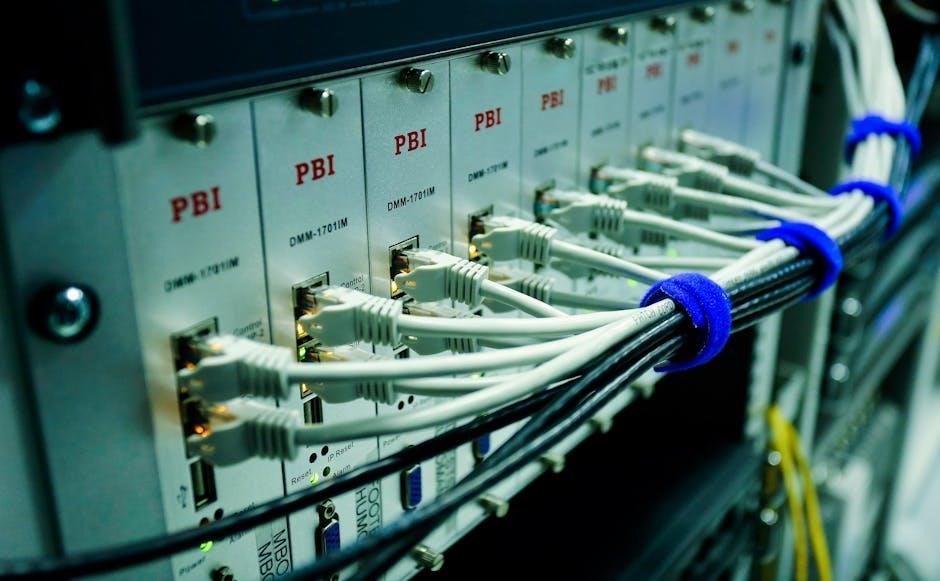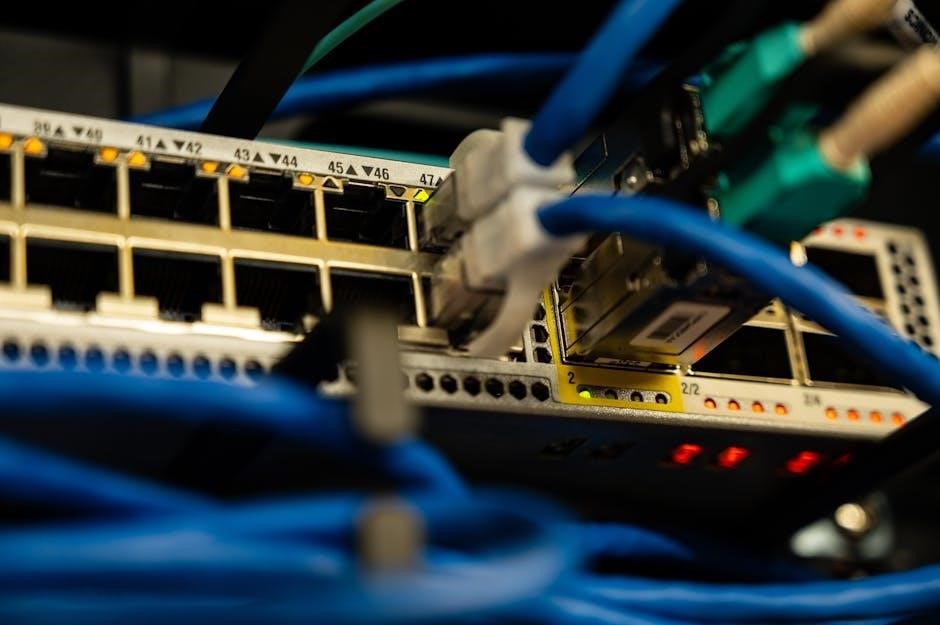LAN cable color coding is a standardized method for organizing and identifying wire connections in network installations. It ensures consistency, reduces errors, and simplifies troubleshooting by following specific patterns like T568A and T568B standards.
Importance of LAN Cable Color Coding
LAN cable color coding is essential for ensuring proper network installation and maintenance. It provides a clear and consistent method for identifying wire connections, reducing the risk of errors during setup. By following standardized color codes like T568A and T568B, technicians can easily distinguish between different wire pairs, enabling efficient troubleshooting. This system also enhances network organization, making it easier to manage complex cabling infrastructures. Additionally, color coding helps in maintaining uniformity across installations, which is critical for compatibility and performance. It simplifies the process of adding or replacing cables, ensuring minimal downtime and optimal network reliability. Overall, LAN cable color coding is a fundamental practice that supports efficient, scalable, and error-free network configurations.
Brief Overview of LAN Cable Standards
LAN cable standards, primarily T568A and T568B, define the wiring patterns for Ethernet connections. These standards ensure compatibility and proper data transmission across networks. T568A and T568B differ in the arrangement of the green and orange wire pairs, but both support the same network functionalities. These standards are widely adopted in structured cabling systems, providing a reliable framework for installing and maintaining network infrastructure. Adherence to these standards minimizes errors and ensures seamless communication between devices. Additionally, they support various cable types, including straight-through, crossover, and rollover cables, each serving specific connectivity needs. Understanding these standards is crucial for network professionals to ensure efficient and scalable network setups.

Understanding LAN Cable Color Codes
LAN cable color codes define wire arrangements in Ethernet cables, ensuring proper data transmission. Standards like T568A and T568B specify pair colors and their positions for network functionality.
T568A Color Code Standard
The T568A color code standard is one of the most widely used wiring standards for Ethernet cables. It specifies the arrangement of wires in an RJ-45 connector, ensuring proper data transmission. The standard assigns specific colors to each wire pair: white/green, green, white/orange, blue, white/blue, orange, white/brown, and brown. These colors are paired and arranged in a specific order to maintain consistency. For a straight-through cable, both ends follow the same T568A pinout, making it suitable for connecting devices like PCs to switches or routers. This standard is often preferred for its compatibility with older network infrastructures and its simplicity in troubleshooting. By adhering to T568A, network installers ensure reliable connections and minimize signal interference.
T568B Color Code Standard
The T568B color code standard is another widely adopted wiring standard for Ethernet cables, serving as an alternative to T568A. It differs primarily in the arrangement of the orange and green wire pairs. In T568B, the white/orange, orange, white/green, and green wires are swapped compared to T568A. This standard is commonly used in newer network installations and is compatible with modern devices. Like T568A, T568B ensures reliable data transmission by maintaining consistent wiring patterns. Both standards are interchangeable in most cases, but consistency across a network is crucial to avoid connectivity issues. T568B is favored for its alignment with certain manufacturer specifications and is often used in high-speed data transmission applications, making it a versatile choice for network setup and organization.
Key Differences Between T568A and T568B

The primary difference between the T568A and T568B color code standards lies in the arrangement of the wire pairs. In T568A, the white/green, green, white/orange, and orange wires are positioned in specific pins, while T568B swaps the positions of the orange and green pairs. This means T568B uses white/orange, orange, white/green, and green wires in those pins. Both standards are interchangeable in most network setups, but consistency is crucial to avoid connectivity issues. T568B is often preferred in newer installations and is compatible with certain manufacturer specifications. Despite these differences, both standards ensure reliable data transmission when applied correctly. The choice between T568A and T568B typically depends on the network environment and specific requirements, but either standard can be used effectively as long as it is applied uniformly across the network.

Types of LAN Cables and Their Color Coding
LAN cables include Straight-Through, Crossover, and Rollover types, each with specific color coding standards like T568A and T568B. These codes ensure proper wire arrangement for reliable network connections.
Straight-Through Cable Color Code
A Straight-Through cable is used to connect dissimilar devices, such as a PC to a switch or a printer. The color coding for this cable follows the T568A or T568B standard on both ends, ensuring the same wire arrangement at both connectors. For T568A, the color order is: White/Green, Green, White/Orange, Blue, White/Blue, Orange, White/Brown, Brown. For T568B, the order is: White/Orange, Orange, White/Green, Blue, White/Blue, Green, White/Brown, Brown. This consistency ensures proper data transmission and avoids signal crossover issues. Straight-Through cables are the most common type used in LAN setups, making them essential for reliable network connections.
Crossover Cable Color Code
A Crossover cable connects similar devices, such as PC-to-PC, switch-to-switch, or hub-to-hub. Its color coding differs from Straight-Through cables by swapping the Green and Orange pairs. Using the T568A standard on one end and T568B on the other achieves this. For example, one end follows T568A: White/Green, Green, White/Orange, Blue, White/Blue, Orange, White/Brown, Brown. The other end uses T568B: White/Orange, Orange, White/Green, Blue, White/Blue, Green, White/Brown, Brown. This crossover configuration allows devices to communicate without the need for a network switch, enabling direct data transfer between connected devices. Proper wiring ensures reliable performance and prevents signal interference.
Rollover Cable Color Code
A Rollover cable is used to connect a PC to the console port of a router or network device. Its color coding is unique, as the wiring is reversed on one end. For example, Pin 1 on one connector connects to Pin 8 on the other, Pin 2 to Pin 7, and so on. This creates an interface for device configuration rather than data transfer. The color code follows a specific pattern: White/Orange, Orange, White/Green, Blue, White/Blue, Green, White/Brown, Brown on one end, and the reverse on the other. Unlike Straight-Through or Crossover cables, Rollover cables are not used for data transmission but for establishing management connections. This wiring ensures compatibility with console ports, enabling administrators to configure network devices effectively.

Practical Applications of LAN Cable Color Coding
LAN cable color coding simplifies network organization, troubleshooting, and installation by using standardized patterns. It ensures consistent wiring, reduces errors, and enhances readability, making network management more efficient and reliable.
Best Practices for LAN Cable Color Coding
Adhering to standardized color coding ensures reliable network performance and simplifies troubleshooting. Always follow T568A or T568B standards consistently across the network. Use high-quality cable ties or labels to organize cables by type or purpose. Test cables before installation to verify connectivity. Document the color coding scheme for future reference. Avoid mixing different standards in the same setup to prevent signal interference. Use color-coded cables for specific applications, such as yellow for PoE connections, to enhance visibility. Regularly inspect cables for damage or mislabeling. Train personnel on color coding to maintain consistency. These practices ensure efficient network organization, reduce downtime, and improve scalability.

Using Color Coding for Network Organization
Color coding is a crucial tool for maintaining organized and efficient network infrastructure. By assigning specific colors to different cable types, such as yellow for PoE connections or blue for data drops, network administrators can quickly identify cable purposes. This system enhances readability and reduces the risk of human error. Color-coded cables also simplify troubleshooting by allowing technicians to trace connections visually. Additionally, using consistent color schemes across the network ensures uniformity and makes documentation easier. Many organizations extend this practice to label ports, switches, and routers, creating a cohesive system that streamlines maintenance and upgrades. Implementing a color-coded strategy not only improves network reliability but also saves time during installations and repairs. It is a simple yet effective method for managing complex network environments. This approach is widely recommended in structured cabling best practices.

Step-by-Step Guide to Wiring LAN Cables
Strip the cable, untwist pairs, arrange wires per T568A/B standards, trim to 0.5 inches, and crimp securely for reliable connections using a crimper tool.
Tools and Materials Needed
To successfully wire a LAN cable, you will need specific tools and materials. Start with a cable stripper to remove the outer jacket, and a wire cutter or scissors for trimming. A crimper is essential for securely attaching RJ45 connectors to the cable ends. Additionally, a cable tester can verify the connectivity and detect any faults. For materials, use high-quality CAT5e or CAT6 cable, along with RJ45 connectors. Optional items include cable boots for strain relief and cable labels for better organization. Ensure all tools are compatible with the cable type to avoid damage or poor connections. Proper tools and materials are critical for achieving reliable and professional results in network wiring.
Step-by-Step Wiring Instructions

Start by stripping the LAN cable to expose the inner wires. Untwist the pairs and straighten them for easier handling. Arrange the wires according to the chosen standard (T568A or T568B). Trim the wires to equal lengths, leaving about 0.5 inches exposed. Insert the wires into an RJ45 connector, ensuring proper alignment with the pinout diagram. Use a crimper to secure the connector firmly. Repeat the process for the other end of the cable. For crossover cables, reverse the wire order on one end. Finally, test the cable using a cable tester to verify all connections are correct and functioning properly. This ensures reliable performance and minimizes potential issues in your network setup.

Wiring Diagrams and References
Wiring diagrams provide visual guides for T568A and T568B standards, ensuring proper LAN cable connections. They clarify pinout configurations, making installations and troubleshooting easier for network professionals. Referencing these diagrams helps maintain consistency and avoids common wiring errors, ensuring reliable network performance and minimizing downtime. PDF guides often include detailed illustrations, offering a quick reference for both straight-through and crossover cable setups. These resources are essential for anyone working with LAN cables, ensuring accuracy and efficiency in network installations. Always consult up-to-date diagrams to adhere to current standards and best practices in structured cabling systems. Proper references guarantee that cables are wired correctly, reducing the risk of connectivity issues and ensuring optimal network functionality. By following these guidelines, professionals can ensure seamless communication across devices and maintain a robust network infrastructure. Accurate wiring diagrams and references are indispensable tools for achieving reliable and efficient network setups, making them a cornerstone of successful LAN installations.
T568A and T568B Wiring Diagrams
T568A and T568B wiring diagrams are essential visual guides for correctly connecting LAN cables. These diagrams illustrate the pinout configurations for both standards, ensuring proper wire arrangement. T568A and T568B differ primarily in the placement of the orange and green wire pairs. T568A typically uses the sequence: white/green, green, white/orange, blue, white/blue, orange, white/brown, brown. T568B, on the other hand, uses white/orange, orange, white/green, blue, white/blue, green, white/brown, brown. These diagrams are critical for installing straight-through and crossover cables, as they specify which wires connect to which pins in RJ45 connectors. By following these diagrams, professionals can avoid common wiring errors, ensuring reliable network performance. Tools like cable strippers and crimpers are often used alongside these guides to create precise connections. Consistency in following T568A or T568B standards is vital to prevent signal interference and connectivity issues. Wiring diagrams are also invaluable for troubleshooting and verifying cable integrity. They are widely available in Guides or PDFs, offering clear visual references for network installations.

Importance of Consistent Wiring
Consistent wiring is critical for ensuring reliable network performance and minimizing errors. Properly following T568A or T568B standards guarantees signal integrity, reduces electromagnetic interference, and simplifies troubleshooting. Inconsistent wiring can lead to connectivity issues, data loss, and increased downtime. Adhering to a single standard across all cables ensures compatibility and avoids confusion during network maintenance. Additionally, consistent wiring makes it easier to identify and resolve faults, as technicians can rely on predictable configurations. It also ensures compliance with industry standards, which is essential for professional network installations. By maintaining uniform wiring practices, organizations can optimize their network infrastructure, improve performance, and reduce operational challenges. Consistency is the cornerstone of a well-functioning and scalable network environment.
Mastery of LAN cable color coding ensures efficient network setups and troubleshooting. Adhering to T568A and T568B standards is crucial for reliable connections; For further learning, explore detailed PDF guides and wiring diagrams available online, which provide comprehensive insights and practical examples for professional installations. These resources are invaluable for both beginners and experienced technicians seeking to refine their skills in network cable management and organization.
Common Mistakes to Avoid
When working with LAN cable color coding, several common mistakes can lead to connectivity issues. One of the most frequent errors is mixing T568A and T568B standards within the same cable, which can cause signal crossover and data loss. Another mistake is improper stripping of the cable jacket, leading to exposed or damaged wires. Additionally, failing to trim wires to the correct length can result in poor connections and performance. Neglecting to follow the color code sequence precisely can also lead to wiring mismatches. It’s crucial to use the appropriate tools, such as cable strippers and crimpers, to ensure clean and accurate connections. Always double-check the wiring before crimping the RJ45 connector to avoid costly rework and ensure reliable network performance.
Recommended Resources and PDF Guides
For a deeper understanding of LAN cable color coding, several resources and PDF guides are highly recommended. The official TIA/EIA standards documents provide comprehensive details on T568A and T568B wiring. Websites like learnabhi.com offer detailed guides and wiring diagrams for straight-through, crossover, and rollover cables. Additionally, PDF guides from networking equipment manufacturers often include visual aids and step-by-step instructions. Many online forums and tutorials, such as those found on forums and educational websites, share practical tips and troubleshooting techniques. These resources are invaluable for both beginners and experienced professionals, ensuring accurate and reliable network setups. Always refer to up-to-date materials to stay current with industry best practices and standards.
